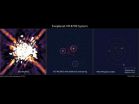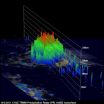(Press-News.org) ATLANTA -- October 6, 2011 -- A new study finds liver cancer incidence rates continue to increase in some low-risk parts of the world such as North America, and are decreasing in some of the highest risk countries of Asia. Despite this, the incidence rates in Asian countries remain twice as high as those in Africa and more than four times as high as rates in North America. The study will be published in an upcoming issue of Cancer Epidemiology Biomarkers and Prevention and appears early online.
Using data from the International Agency for Research on Cancer, American Cancer Society epidemiologists Melissa M. Center, MPH and Ahmedin Jemal, PhD examined recent trends in liver cancer incidence rates from 1993 to 2002 for 32 cancer registries worldwide. They also examined the male to female rate ratios for these and four additional registries, based on the 1998 incidence data.
They found liver cancer incidence rates for both men and women increased from 1993 to 2002 for eight of the 32 cancer registries considered in the analysis. Increases were largely confined to economically developed countries of Western Europe, North America, and Oceania and may be partly due to increased chronic HCV infection as a result of unscreened blood transfusions and contaminated needles used for medical purposes and with widespread intravenous drug use in previous decades. In contrast, rates decreased in both men and women in five registries including three in Asia. Despite this, incidence rates in Asian countries remain three to four times higher than those in low-risk areas with increasing rates. Male to female rate ratios varied from 0.9 in sub-Saharan African and South American registries to 5.0 (five men for every woman diagnosed) in France and Egypt.
The authors conclude that liver cancer incidence rates continue to increase in some low-risk parts of the world, while they are now decreasing in some of the highest risk countries in Asia. Additional studies looking at causation are needed, they say, to further elucidate factors contributing to these divergent liver cancer incidence trends worldwide.
"We hope our description of international liver cancer incidence trends may stimulate studies to further illustrate etiologic factors associated with these divergent liver cancer incidence trends worldwide," said Ms. Center.
###
Article: International Trends in Liver Cancer Incidence Rates, Melissa M. Center and Ahmedin Jemal, Cancer Epidemiol Biomarkers Published OnlineFirst September 15, 2011; doi: 10.1158/1055-9965.EPI-11-0643.
Study finds liver cancer increasing in low risk countries, decreasing in high risk countries
2011-10-10
ELSE PRESS RELEASES FROM THIS DATE:
Marijuana use may double the risk of accidents for drivers
2011-10-10
October 6, 2011 -- Over 10 million people age 12 or older are estimated to have driven under the influence of illicit drugs in the prior year, according to a 2009 National Survey on Drug Use and Health. While marijuana is the most commonly detected non-alcohol drug in drivers, its role in causing crashes has remained in question. To examine the link between marijuana use by drivers and risk of a car accident, researchers at Columbia University did a meta-analysis of nine epidemiologic studies and found that drivers who test positive for marijuana or report driving within ...
Why does conflict arise when social identity is threatened?
2011-10-10
Be it at school, office, the neighborhood or the community people live in, conflicting situations amongst various groups might arise on an almost day to day basis. Today, the prevalence of these intergroup conflicts is on the rise and has resulted in minor disagreements amongst friends to waging full scale wars between countries.
Social psychology research has always maintained that individuals often identify themselves with the social group they belong to and will bond together to defend their identity at all cost. Now, a new study published in the latest issue of Psychological ...
Astronomers find elusive planets in decade-old Hubble data
2011-10-10
In a painstaking re-analysis of Hubble Space Telescope images from 1998, astronomers have found visual evidence for two extrasolar planets that went undetected back then.
Finding these hidden gems in the Hubble archive gives astronomers an invaluable time machine for comparing much earlier planet orbital motion data to more recent observations. It also demonstrates a novel approach for planet hunting in archival Hubble data.
Four giant planets are known to orbit the young, massive star HR 8799, which is130 light-years away. In 2007 and 2008 the first three planets were ...
Researchers find race disparity in post-hospital arrival homicide deaths at trauma centers
2011-10-10
AMHERST, Mass. -- New research based on post-hospital arrival data from U.S. trauma centers finds that even after adjusting for differences in injury severity, gun use, and other likely causes of race difference in death from assault, African-Americans have a significantly higher overall post-scene of injury mortality rate than whites. The study was conducted by Anthony R. Harris, emeritus professor of sociology at the University of Massachusetts Amherst, and colleagues and published in August by the Journal of Trauma, Injury, Infection and Critical Care.
The study, ...
People without cars, financial assets less likely to marry: study
2011-10-10
A study published this week in the American Journal of Sociology finds that people who lack personal wealth in the form of a car or financial assets are significantly less likely to enter into a first marriage. The results, according to study author Daniel Schneider of Princeton University, shed light on recent changes in marriage patterns in the U.S.
For the past few decades, Americans have been getting married later in life and are becoming more likely forego marriage altogether. Between 1970 and 2000, the median age of first marriage in the U.S. rose by about four ...
NASA's Aqua satellite sees birth of two tropical cyclones in Eastern Pacific
2011-10-10
The tropics in the eastern Pacific were quiet for a couple of days after Hurricane Hilary dissipated, and today gave birth to Tropical Depression 10 and Tropical Storm Irwin. NASA's Aqua satellite captured an infrared image of both storms and saw the powerful convection in the center of Irwin that enabled the storm to go from a depression to a tropical storm in a short time.
The eleventh tropical depression quickly grew into Tropical Storm Irwin this morning, as strong convection surged around its center of circulation. That convection (rising air that creates the thunderstorms ...
A 3-D look at Philippe provided clues of transition into a hurricane
2011-10-10
Tropical Storm Philippe took its time to strengthen into a hurricane because of wind shear problems. The wind shear lessened, and Philippe became a hurricane today, after 12 days of moving across the Atlantic Ocean. NASA's TRMM satellite saw towering thunderstorms and intense rainfall within Philippe yesterday, which provided forecasters with a clue that the storm was strengthening. Philippe reached hurricane status this morning, Oct. 6, 2011.
Over two days, the Tropical Rainfall Measuring Mission (TRMM) satellite provided forecasters with cloud heights and rainfall rates ...
Astrophysicists spot pulsed radiation from Crab Nebula that wasn't supposed to be there
2011-10-10
An international collaboration of astrophysicists, including a group from the Department of Physics in Arts & Sciences at Washington University in St. Louis, has detected pulsed gamma rays from the neutron star at the heart of the Crab Nebula with energies far higher than the common theoretical models can explain.
The pulsed gamma rays had energies between 100 and 400 billion electronvolts (Gigaelectronvolts, or GeV), far higher than 25 GeV, the highest energy radiation from the neubla previously detected. A 400 GeV photon is 11 orders of magnitude – almost a trillion ...
Crab Pulsar emits light at highest energies ever detected in a pulsar system, scientists report
2011-10-10
An international team of scientists has detected the highest energy gamma rays ever observed from a pulsar, a highly magnetized and rapidly spinning neutron star.
The VERITAS experiment measured gamma rays coming from the Crab Pulsar at such large energies that they cannot be explained by current scientific models of how pulsars behave, the researchers said.
The results, published today in the journal Science, outline the first observation of photons from a pulsar system with energies greater than 100 billion electron volts -- more than 50 billion times higher than ...
Sniffing out the brain's predictive power
2011-10-10
CHICAGO --- In the moments before you "stop and smell the roses," it's likely your brain is already preparing your sensory system for that familiar floral smell. New research from Northwestern Medicine offers strong evidence that the brain uses predictive coding to generate "predictive templates" of specific smells -- setting up a mental expectation of a scent before it hits your nostrils.
Predictive coding is important because it provides animals -- in this case, humans -- with a behavioral advantage, in that they can react more quickly and more accurately to stimuli ...




